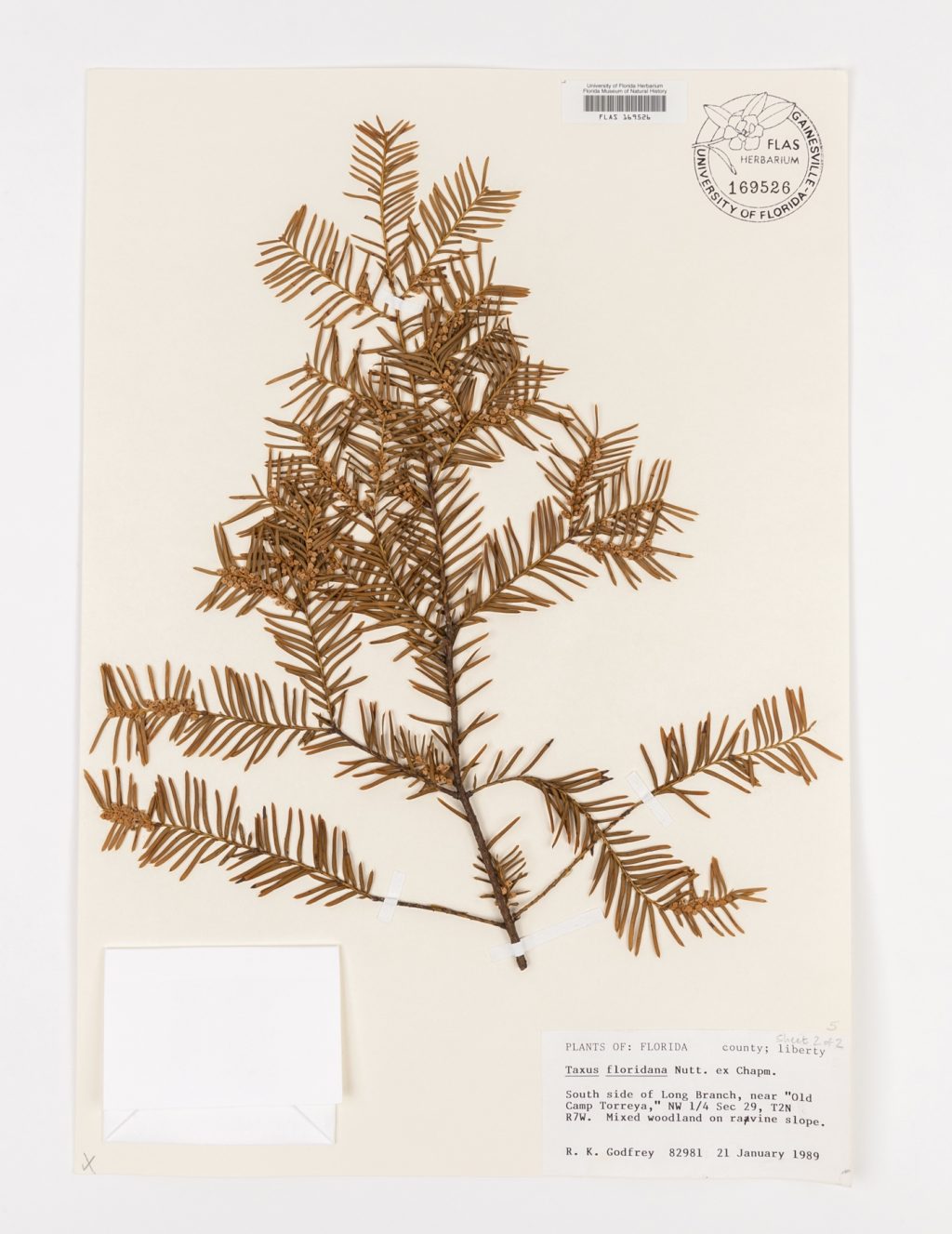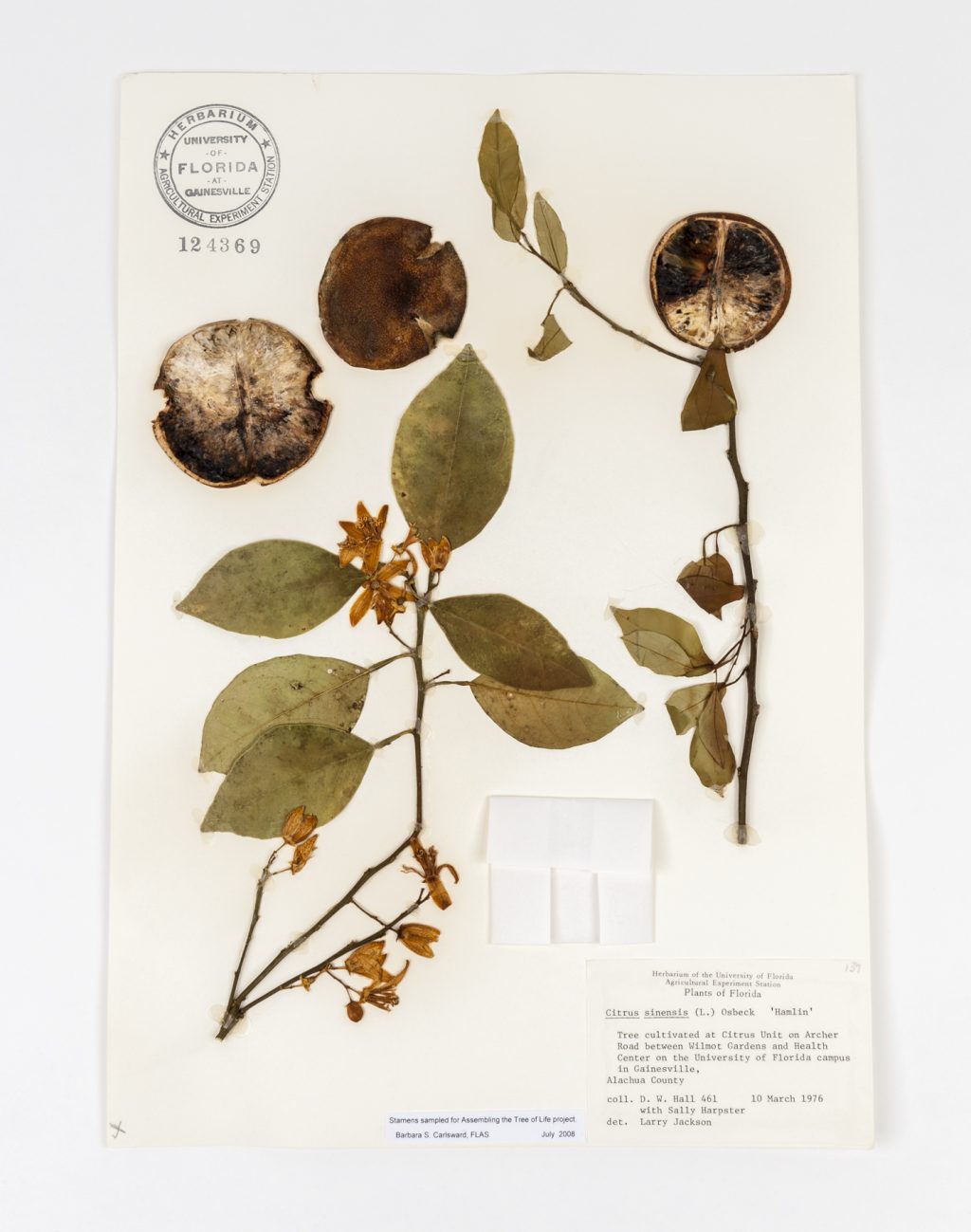How Can Data From A Plant Herbarium Be Used
While some might printing flowers into books to preserve their beauty, researcher Mark Whitten does it to preserve history.
Whitten, a botanist in the Florida Museum of Natural History Herbarium, glues pressed plants onto archival paper and stores them as specimens in the museum'south collection.
He said herbarium specimens show data about plants' location, habitat, flowers and fruits at the time of their drove. With this data, researchers are starting to make connections about recent climate change and its influence on the seasonal cycles of plants, or plant phenology.
Whitten said researchers lack practiced observational records on when plants offset to flower, produce fruit or course leaves, which is where herbarium specimens come up in.

Florida Museum photograph past Kristen Grace
"If you get plenty samples, statistically you're going to be able to go a pretty good window on the flowering period of a constitute," he said. "And then you tin can correlate that with the temperature records of the site and ask the question: In 1880, were these plants flowering later or earlier than they are now?"
Whitten said shifts in climate, such equally warming temperatures, tin cause plants to blossom earlier, before their pollinators are out, which prevents the plants from reproducing.
He said some studies, however, take shown that certain plants aren't afflicted past changing temperatures.
"Some plants seem to not really 'care' what the spring temperatures are," Whitten said. "Whether it's 50 degrees or 80 degrees, they're not going to flower until the twenty-four hour period length reaches a certain number of hours."
Pam Soltis, a distinguished professor and curator at the museum, worked with colleagues to produce a review paper in Trends in Ecology and Development on how herbarium specimens can be used to predict the effects of climate change on constitute phenology.
"Some species may accept the potential to move northward because that's where the all-time climate volition be for them in the time to come," she said.
Soltis has found that comparing data from the by to the present can help decide future patterns in constitute behavior.
"Even in Florida, we've seen over the last lx years or then a pattern where species have responded to warming and drying climates in means that nosotros predict are going to happen into the future," she said in reference to some of the Florida Museum Herbarium specimens.
Although stale herbarium specimens preserve many plant features, including Deoxyribonucleic acid, simply keeping them pressed to newspaper makes it difficult for many people to access the information they hold. Soltis said this is why digitization of data is growing apace. Digitization helps make all of the Florida Museum'southward specimens globally bachelor, which in turn fosters collaboration with other museums.
"There are more than and more than data bachelor all the time from collections around the earth," she said. "(Digitization) has all happened just in the last six or seven years, then it'southward merely amazing to see what'due south happening and how rapidly. It but opens upwardly all kinds of additional research."
Whitten said the process of digitizing the Florida Museum's herbarium collection is ongoing, with about l percent of the collection digitized to date and 30 pct available online.

Florida Museum photo by Kristen Grace
Charles Willis, an acquaintance of the Department of Organismic and Evolutionary Biology at Harvard University and a study co-writer, said herbarium specimens are reliable sources of data but remain largely untapped resources because many people only view them as tools for classification.
"Information technology'due south incredibly vital, considering if we're going to understand how climate change is going to impact non just biology in general, merely specific communities, we need to know how those individuals in those communities are going to respond," he said.
Willis said he has only found about xxx studies that examined a few hundred thousand specimens of the millions establish effectually the earth.
"Nosotros but wanted to bring attending to the customs that this is possible, that we can employ these specimens for more than just archetype taxonomic studies," he said. "It'southward really up to the community at present to effigy out new and novel ways to do inquiry with herbarium specimens."
Going forward, Soltis said looking at phenology with the assist of herbarium specimens is of import because they tin aid place which country to conserve for the future.
"I think information technology's a actually disquisitional time for united states of america to use any sorts of resource we take available, and this is a relatively new set of information," she said. "As we predict future distributions, we can see if a group of species might answer to climate change in the aforementioned fashion. If and then, nosotros tin possibly use this information to set bated land areas for time to come conservation. Maybe we don't necessarily want to preserve only where species occur at present, but nosotros might desire to recollect about where they volition be in the hereafter."
The paper is the issue of a workshop sponsored by iDigBio in March 2016.
- Learn more about the Herbarium at the Florida Museum.
- Mind to the stories backside the Museum'southward Florida yew and orange blossom specimens.
- Acquire more about the Soltis Lab at the Florida Museum.
How Can Data From A Plant Herbarium Be Used,
Source: https://www.floridamuseum.ufl.edu/science/herbarium-specimens-provide-snapshots-of-plants-past-data-for-future/
Posted by: mazurfident75.blogspot.com


0 Response to "How Can Data From A Plant Herbarium Be Used"
Post a Comment